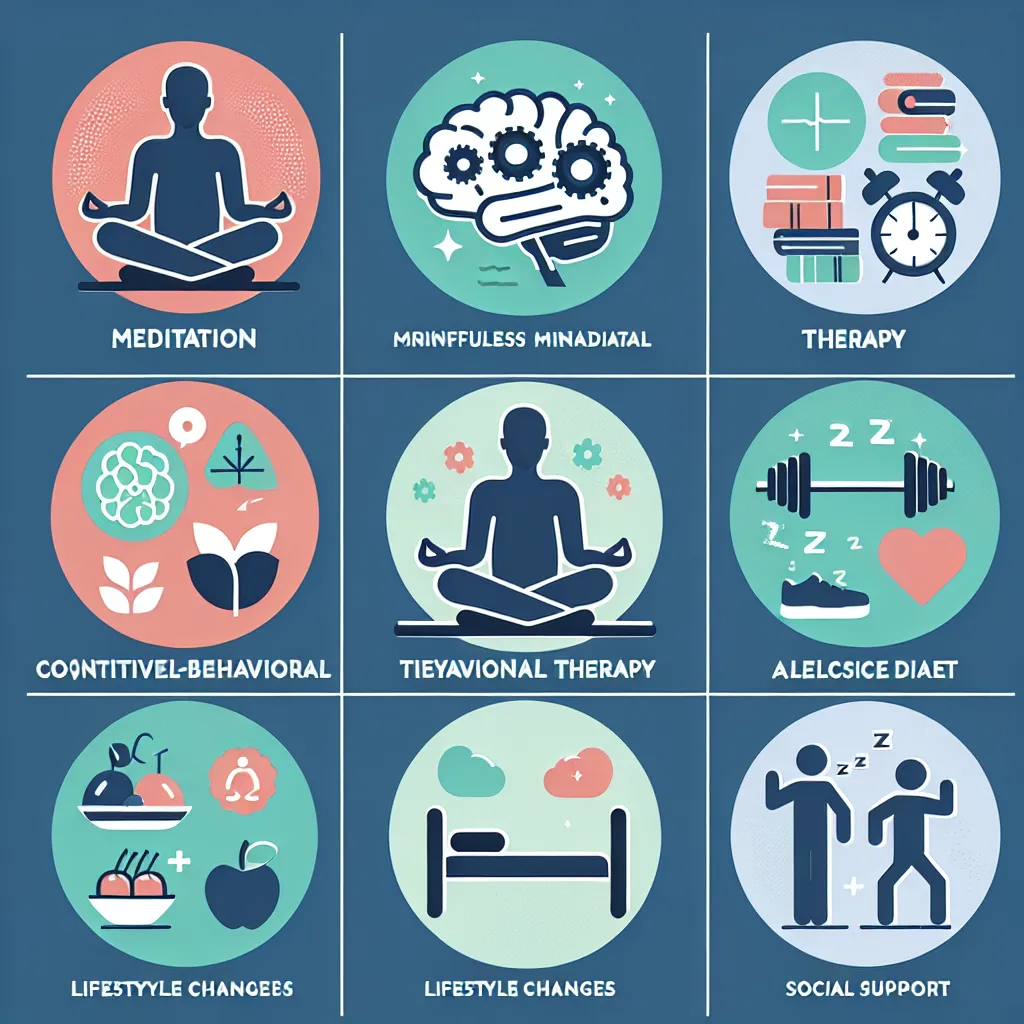The IELTS Reading section is a crucial component of the test, requiring candidates to demonstrate their ability to comprehend complex texts and answer various question types accurately. Today, we’ll focus on a topic that has become increasingly relevant in recent years: the best ways to reduce anxiety. This subject has appeared in several IELTS Reading passages over the past decade, reflecting its growing importance in our modern society. Given the current global climate and the ongoing emphasis on mental health, it’s highly likely that similar themes will continue to feature in future IELTS exams.
Nội dung bài viết
Let’s dive into a practice reading passage on this topic, followed by a set of questions that mirror the format and difficulty level you might encounter in the actual IELTS test.
Reading Passage
Effective Strategies for Anxiety Reduction
Anxiety is a pervasive issue in today’s fast-paced world, affecting millions of people globally. While some level of anxiety is a normal part of life, excessive worry and fear can significantly impact one’s quality of life. Fortunately, there are numerous evidence-based strategies that individuals can employ to manage and reduce anxiety effectively.
One of the most widely recommended approaches is mindfulness meditation. This practice involves focusing one’s attention on the present moment, acknowledging and accepting thoughts and feelings without judgment. Regular mindfulness practice has been shown to reduce anxiety symptoms by helping individuals develop a more balanced perspective on their worries. Research conducted at Harvard Medical School found that an eight-week mindfulness program led to significant reductions in anxiety levels among participants.
Another powerful tool in the fight against anxiety is cognitive-behavioral therapy (CBT). This form of psychotherapy helps individuals identify and challenge negative thought patterns that contribute to anxiety. By learning to recognize and reframe these thoughts, people can develop more realistic and positive ways of thinking. A meta-analysis published in the Journal of Clinical Psychology revealed that CBT is highly effective in treating various anxiety disorders, with success rates ranging from 60% to 80%.
Physical exercise is also a potent anxiety-reducer. Regular aerobic activity has been shown to decrease overall levels of tension, elevate mood, and improve sleep and self-esteem. A study published in the Archives of Internal Medicine found that people who engaged in regular physical activity were 25% less likely to develop an anxiety disorder over a five-year period compared to sedentary individuals.
Lifestyle modifications can play a significant role in anxiety management as well. Reducing caffeine intake, for instance, can help alleviate symptoms for many people. Caffeine is a stimulant that can exacerbate feelings of nervousness and jitteriness, particularly in anxiety-prone individuals. Similarly, maintaining a consistent sleep schedule is crucial, as sleep deprivation can heighten anxiety levels. The National Sleep Foundation recommends adults aim for 7-9 hours of sleep per night for optimal mental health.
Social support is another key factor in anxiety reduction. Connecting with others, whether through one-on-one conversations, support groups, or community activities, can provide a sense of belonging and reduce feelings of isolation often associated with anxiety. A study in the Journal of Affective Disorders found that perceived social support was negatively correlated with anxiety symptoms, highlighting the importance of maintaining strong social connections.
While these strategies can be highly effective, it’s important to note that severe anxiety may require professional help. Psychotherapy, medication, or a combination of both can be necessary for managing more persistent or debilitating forms of anxiety. Seeking help from a mental health professional is a sign of strength, not weakness, and can be a crucial step towards reclaiming one’s life from the grip of anxiety.
In conclusion, while anxiety can be a challenging condition to manage, there are numerous proven strategies available to help individuals reduce its impact on their lives. By incorporating mindfulness, cognitive-behavioral techniques, regular exercise, lifestyle modifications, and social support into their daily routines, many people can significantly alleviate their anxiety symptoms and improve their overall quality of life.
 Anxiety reduction strategies infographic
Anxiety reduction strategies infographic
Questions
True/False/Not Given
Do the following statements agree with the information given in the reading passage? Write
TRUE if the statement agrees with the information
FALSE if the statement contradicts the information
NOT GIVEN if there is no information on this
- Mindfulness meditation helps reduce anxiety by encouraging people to focus on future events.
- Cognitive-behavioral therapy is effective for treating various types of anxiety disorders.
- People who exercise regularly are less likely to develop anxiety disorders over time.
- Caffeine consumption has no impact on anxiety levels.
- The National Sleep Foundation recommends 6-8 hours of sleep per night for adults.
Multiple Choice
Choose the correct letter, A, B, C, or D.
-
According to the passage, which of the following is NOT mentioned as a strategy for reducing anxiety?
A) Mindfulness meditation
B) Cognitive-behavioral therapy
C) Acupuncture
D) Regular exercise -
The study published in the Archives of Internal Medicine found that regular physical activity:
A) Completely eliminates the risk of developing anxiety disorders
B) Reduces the likelihood of developing an anxiety disorder by 25%
C) Has no significant impact on anxiety levels
D) Is only effective when combined with medication
Matching Information
Match the following statements (8-11) with the correct strategy (A-E) mentioned in the passage. Write the correct letter A-E in boxes 8-11 on your answer sheet.
A) Mindfulness meditation
B) Cognitive-behavioral therapy
C) Physical exercise
D) Lifestyle modifications
E) Social support
- Helps individuals challenge negative thought patterns
- Involves focusing on the present moment without judgment
- Can improve sleep and self-esteem
- Provides a sense of belonging and reduces isolation
Short Answer Questions
Answer the following questions using NO MORE THAN THREE WORDS from the passage for each answer.
- What type of therapy helps individuals identify and challenge negative thought patterns?
- According to the passage, what should be reduced to help alleviate anxiety symptoms?
- What does the passage suggest seeking if anxiety is severe or persistent?
Answer Key
- FALSE
- TRUE
- TRUE
- FALSE
- FALSE
- C
- B
- B
- A
- C
- E
- Cognitive-behavioral therapy
- Caffeine intake
- Professional help
Explanation
- FALSE – The passage states that mindfulness meditation involves focusing on the present moment, not future events.
- TRUE – The passage mentions that CBT is highly effective in treating various anxiety disorders.
- TRUE – The study cited shows that regular exercisers were 25% less likely to develop anxiety disorders.
- FALSE – The passage states that reducing caffeine intake can help alleviate anxiety symptoms.
- FALSE – The National Sleep Foundation recommends 7-9 hours, not 6-8 hours.
- C – Acupuncture is not mentioned in the passage as a strategy for reducing anxiety.
- B – The study found that regular physical activity reduces the likelihood of developing an anxiety disorder by 25%.
- B – Cognitive-behavioral therapy helps identify and challenge negative thought patterns.
- A – Mindfulness meditation involves focusing on the present moment without judgment.
- C – Physical exercise is mentioned to improve sleep and self-esteem.
- E – Social support provides a sense of belonging and reduces isolation.
- Cognitive-behavioral therapy – This is directly stated in the passage.
- Caffeine intake – The passage mentions reducing caffeine intake can help alleviate anxiety symptoms.
- Professional help – The passage suggests seeking professional help for severe or persistent anxiety.
Common Mistakes
-
Misinterpreting “Not Given” answers: Remember, if the information is not explicitly stated in the passage, it should be marked as “Not Given,” even if it seems logical or true in general.
-
Overlooking key words: Pay close attention to qualifiers like “some,” “most,” or “all,” as they can change the meaning of a statement significantly.
-
Falling for distractors in multiple-choice questions: Always check all options before selecting an answer, as distractors may seem partially correct.
-
Exceeding word limits in short answer questions: Strictly adhere to the word limit given, even if it means using incomplete sentences.
-
Failing to use information from the entire passage: Some questions may require synthesizing information from different parts of the text.
Vocabulary
- Pervasive (adjective) /pəˈveɪsɪv/ – spreading widely throughout an area or group of people
- Mindfulness (noun) /ˈmaɪndfəlnəs/ – the practice of being aware of your body, mind, and feelings in the present moment
- Cognitive-behavioral therapy (noun) /ˌkɒɡnətɪv bɪˈheɪvjərəl ˈθerəpi/ – a type of psychotherapy that helps people change unhelpful or unhealthy thinking habits and behaviors
- Meta-analysis (noun) /ˌmetə əˈnæləsɪs/ – a statistical technique for combining the findings from independent studies
- Sedentary (adjective) /ˈsedəntəri/ – tending to spend much time seated; somewhat inactive
- Exacerbate (verb) /ɪɡˈzæsərbeɪt/ – make (a problem, bad situation, or negative feeling) worse
Grammar Focus
Pay attention to the use of conditional sentences in the passage:
“While these strategies can be highly effective, it’s important to note that severe anxiety may require professional help.”
This is an example of a mixed conditional sentence, combining a zero conditional (general truth) in the first clause with a first conditional (possible future scenario) in the second clause. Such structures are common in academic writing to express nuanced ideas and possibilities.
Tips for High Scores in IELTS Reading
- Time management: Allocate your time wisely across all sections of the reading test.
- Skim and scan: Quickly skim the passage for general understanding, then scan for specific information.
- Read questions carefully: Understand exactly what each question is asking before searching for the answer.
- Use context clues: If you encounter unfamiliar words, try to deduce their meaning from the surrounding context.
- Practice regularly: Familiarize yourself with various question types and passage structures through consistent practice.
- Improve your vocabulary: Build your academic vocabulary to better understand complex texts.
- Stay calm: Remember that anxiety can impact your performance, so practice relaxation techniques to use during the test.
By following these strategies and practicing regularly with passages like the one above, you can significantly improve your performance in the IELTS Reading section. Remember, the best ways to reduce stress can also be applied to manage test anxiety, helping you perform at your best on exam day.


